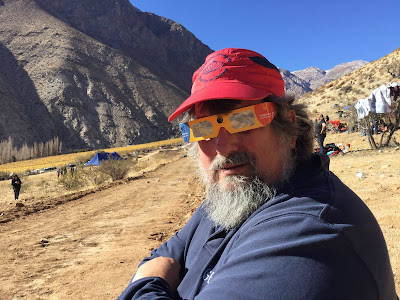Where is Latin America exactly, and why is it called that?
What causes deforestation in the Amazon, and why does it matter?
 |
Infamous BR-364
See note below |
What do migration patterns have to do with the price of coffee?How is land connected to political upheaval in the region?
How does climate change affect Latin America, and how are people responding?
What can we learn about Latin America from its music?
These questions and many more are part of one of my favorite courses --
GEOG 381 is Latin America: Globalization & Cohesion
Tuesdays 11:00am-12:15pm
In the spring 2021 semester it is offered fully online, partly synchronous. This is a complicated way to say that we will have one Zoom meeting a week, with students working independently otherwise.
International development amid the diverse global cultures of Latin America and the Caribbean is considered as globalization is balanced with local identities from the Rio Grande to Tierra del Fuego. Common themes that define the region are contrasted with unique developments at national and local scales.
The course meets four requirements of the Core Curriculum: CGCL; CMCL; CSOC; CWRT
Global Culture; Multiculturalism; Social and Behavioral Sciences; Writing Intensive
It also fulfills requirements in all four geography concentrations, the geography minor, and the LACS minor. An Honors Contract credit is available for students completing departmental honors in geography.
I became a Latin Americanist geographer because of one of the problems mentioned above: Amazon deforestation. As I learned more about the region -- eventually earning a doctoral minor in Latin American Area Studies -- I have become enamored of its many cultures, climates, and landscapes. I have had the good fortune of visiting all the countries shown in green below -- returning many times to Brazil, Mexico, and Nicaragua. I also lived for seven years in the Borderlands of Arizona and Texas, which should be included in any discussion of the region.
For more ideas related to this course, please explore the posts I have labeled
GEOG381 in this blog.
Photo Notes
I struggled to find a photo to illustrate this blog post -- even my own modest experience in Latin America has been quite varied. I have been hot, cold, high, low, wet, and dry. I have seen beautiful and occasionally terrible things. I have met so many wonderful people. I compulsively take photos, and each of the thousands I have taken (or have been taken of me) tells a different story.
At the top of this page is a photo my spouse (who is a BSU librarian and Spanish professor) took during our July 2019 visit to
Chile and
Argentina to view a total eclipse of the sun. We learned why people make such a big deal out of those journeys. Traveling as two Latin Americanists made our travel to view the eclipse a very rich experience, as we could do so independently and appreciate many things about the people and places we traversed.
The BR-364 photo is one that I did not take; I found it on a Facebook group called
Rondônia, Minha Querida Rondônia. Like many groups, it features nostalgic photos of a particular place, in this case the Brazilian state where I did my
dissertation research in 1996 and to which I returned in 2000, 2003, and 2019. The phrase "minha querida" means "my dear" and it signifies the affection many people feel for their home state, despite it being a place I chose to research specifically because of its many problems. The muddy road BR-364 (usually called Três-Meia-Quatro) is at the heart of thousands of migration stories and one of the world's most severe and prolonged episodes of deforestation. The story behind this photo will occupy about two weeks of our course, and will touch on many aspects of the geography of an entire region.
The final photo -- the sea of flags -- was taken in the spring of 2018 in Nicaragua, not by me. I led study tours in Nicaragua almost every year from 2006 to 2018, almost always in January. In April of 2018, politics in the country took a very dark turn, which I describe in a series of posts tagged
#SOSNicaragua -- a hashtag that is also on the back of my car to this day. Although this looks like an ordinary photograph, to understand the photo and the reactions to it is to understand a complicated story of political geography that stretches back decades.




No comments:
Post a Comment
Thanks for your comment and your interest in my blog. I will approve your comment as soon as possible. I had to activate comment moderation because of commercial spam; I welcome debate of any ideas I present, but this will not be a platform for dubious commercial messages.